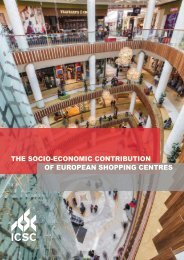THE SOCIO-ECONOMIC CONTRIBUTION OF EUROPEAN SHOPPING CENTRES
Create successful ePaper yourself
Turn your PDF publications into a flip-book with our unique Google optimized e-Paper software.
EXECUTIVE SUMMARY<br />
The shopping centre industry forms an essential layer of the bedrock that supports the European economy<br />
and society. As a major facilitator of retail sales, it is an important contributor to private consumption–the<br />
primary driver of European economic productivity. Beyond consumption, the industry has a significant impact<br />
on other main economic components, notably investment and public spending.<br />
However, the contribution of the shopping centre industry to society is at least equal to its economic importance.<br />
These physical centres help to create and anchor vibrant civic spaces, providing an essential public<br />
place between work and home and a dynamic marketplace for commerce.<br />
Moreover, shopping centres are a prime generator of net employment growth among females and teens and<br />
a critical source of flexible working opportunities for students and senior citizens. Given that virtually every<br />
community across Europe has access to a shopping centre, these economic and social benefits are widely<br />
distributed and accrue at a local, regional, national and multi-national scale.<br />
In short, when the shopping centre industry thrives, so too do the socio-economic conditions in Europe. It<br />
is fortunate then that, taken as a whole, the European shopping centre industry’s vital signs are strong and<br />
retail real estate continues to perform well as measured by a number of key indicators. During a time when<br />
supply has largely been maintained, the European Union has seen increases in both demand for space by<br />
global retailers and in consumer demand for goods and services.<br />
Furthermore, with over 90% of sales still occurring in physical locations, shopping centres remain central to<br />
the success of European retail. The rise of sophisticated omni-channel retail strategies have demonstrated<br />
conclusively that brick-and-mortar stores are an integral part of the consumer experience and are as relevant<br />
now as they have ever been. Whatever the next big retail or technological innovation brings, shopping<br />
centres will remain at the forefront of European commerce as they continue to adapt to meet the changing<br />
needs and wants of consumers.<br />
Select Key Points<br />
• As of 2014, there were 9,263 shopping centres in Europe with over 190 million square metres (sq m) of<br />
lettable area.<br />
• European total retail sales and shopping centre-inclined sales reached all-time highs in 2014, totaling<br />
more than €2.7 trillion and €524.7 billion respectively.<br />
• European total retail sales generated more than €575.7 billion in value added tax (VAT) in 2014, of which<br />
approximately €109.6 billion were derived from shopping centres.<br />
• Approximately €48.7 billion were invested in retail assets across 26 European countries in 2014, of which<br />
€20.6 billion were invested specifically in shopping centres.<br />
• There are roughly 4.2 million shopping centre-related jobs in Europe with the retail industry as a whole<br />
accounting for 1 out of every 11 jobs.<br />
• The retail sector promotes social inclusion and offers flexible working opportunities, particularly for females,<br />
students and retirees.<br />
• Over 90% of total European retail sales still occur in-store. This preference is driven by a desire for a<br />
tactile visual experience and a social interaction that cannot be replicated online.<br />
5



